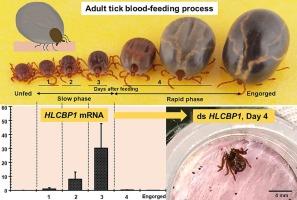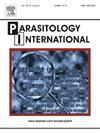A novel chemokine binding protein 1-like gene is vital for the blood pool development and engorgement of the hard tick Haemaphysalis longicornis
IF 1.5
4区 医学
Q3 PARASITOLOGY
引用次数: 0
Abstract
Tick saliva modulates host responses during a blood feeding process. We identified a novel chemokine binding protein 1-like (HLCBP1-like) gene from the salivary glands of the Asian longhorned tick, Haemaphysalis longicornis. The HLCBP1-like protein, lacking a well-defined conserved domain, showed structural similarity to evasin, a chemokine binding protein from the brown dog tick, Rhipicephalus sanguineus. A preliminary knockdown study of HLCBP1-like revealed that ticks with reduced expression of this gene, halted feeding in the early feeding phase, and did not fully-engorge, unlike the control dsRNA (malE) injected ticks. Also, knockdown ticks induced cellular immune responses in the host skin, similar to control dsmalE-injected ticks, but did not show hemorrhage. These findings suggest that HLCBP1-like may play a modulatory role in the slow feeding phase.

一种类似趋化因子结合蛋白 1 的新型基因对硬蜱 Haemaphysalis longicornis 的血池发育和吞噬至关重要。
蜱唾液可调节宿主在吸血过程中的反应。我们从亚洲长角蜱(Haemaphysalis longicornis)的唾液腺中发现了一种新型趋化因子结合蛋白 1-like(HLCBP1-like)基因。HLCBP1-like 蛋白缺乏一个定义明确的保守结构域,其结构与来自褐狗蜱 Rhipicephalus sanguineus 的趋化因子结合蛋白 evasin 相似。对 HLCBP1-like 基因进行的初步敲除研究发现,与注射了 dsRNA(malE)的对照蜱不同,该基因表达减少的蜱在早期摄食阶段停止摄食,并且不会完全吞食。此外,基因敲除的蜱还会诱导宿主皮肤产生细胞免疫反应,这与注射了 dsmalE 的对照蜱相似,但不会出现出血现象。这些研究结果表明,HLCBP1-like 可能在缓慢摄食阶段发挥调节作用。
本文章由计算机程序翻译,如有差异,请以英文原文为准。
求助全文
约1分钟内获得全文
求助全文
来源期刊

Parasitology International
医学-寄生虫学
CiteScore
4.00
自引率
10.50%
发文量
140
审稿时长
61 days
期刊介绍:
Parasitology International provides a medium for rapid, carefully reviewed publications in the field of human and animal parasitology. Original papers, rapid communications, and original case reports from all geographical areas and covering all parasitological disciplines, including structure, immunology, cell biology, biochemistry, molecular biology, and systematics, may be submitted. Reviews on recent developments are invited regularly, but suggestions in this respect are welcome. Letters to the Editor commenting on any aspect of the Journal are also welcome.
 求助内容:
求助内容: 应助结果提醒方式:
应助结果提醒方式:


